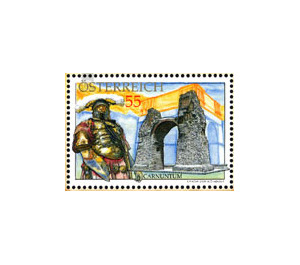Roman excavations - Austria / II. Republic of Austria 2009 - 55 Euro Cent
Theme: Science
| Country | Austria / II. Republic of Austria |
| Issue Date | 2009 |
| Face Value | 55.00 |
| Edition Issued | 250,000 |
| Printing Type | combination printing |
| Stamp Type | Commemorative |
| Item Type | Stamp |
| Chronological Issue Number | 2160 |
| Chronological Chapter | OOS-OE2 |
| SID | 819948 |
| In 22 Wishlists | |
This special stamp block represents a joint edition with the Slovak Republic; He focuses on the two border villages of Carnuntum and Gerulata, whose Roman excavations have great historical significance. With the founding of Carnuntum by the general Tiberius about 2000 years ago, the birth of one of the most important cities of the empire struck. As the capital of the province of Upper Pannonia, Carnuntum was repeatedly in the limelight of world politics in the following centuries. Located at the intersection of Bernsteinstraße and Limesstraße, the city was the meeting point of various cultures. In its heyday Carnuntum had - on an area of about 10 square kilometers - about 50,000 inhabitants. The "germ cell" was the legion camp established in the middle of the 1st century, and under its protection civil life also developed rapidly. After the division of the province of Pannonia around 106 AD, Carnuntum was not only the capital of the newly formed province of Upper Pannonia and seat of the governor, but also the base of the Roman Danube fleet. Around 124 AD, Carnuntum received the official city charter under Emperor Hadrian and became a municipium. In the years 171 to 173 AD, Emperor Marcus Aurelius chose Carnuntum as his residence during his campaign against the Marcomanni. After the governor Septimius Severus was proclaimed emperor in 193 AD by his soldiers in Carnuntum, the city eventually even rose to the rank of "colonia". At the beginning of the 4th century, the city was once again the center of world politics, when it came to the great imperial conference in 308 AD. After the withdrawal of the Romans in the middle of the 5th Century Carnuntum fell but more and more into oblivion. Gerulata, meanwhile, was a Roman military camp near today's Rusovce, a district of the Slovak capital Bratislava. It was also located in the Roman province of Pannonia and was built in the 2nd century as part of the Danube limes. However, the camp was abandoned in the 4th century. The best preserved structure is undoubtedly the foundation of a square house with a floor area of 30 by 30 meters and walls about two and a half meters thick. An exhibition of the Municipal Museum Bratislava is located next to the former camp site. The national cultural asset "Roman fort Gerulata", which is often referred to as "piece of Rome not far from Bratislava", is currently undergoing a phase of positive change. The City of Bratislava's Department of International Relations has recently completed a number of projects, funded by EU funds, which help to present this significant cultural asset to the public in a new way.


